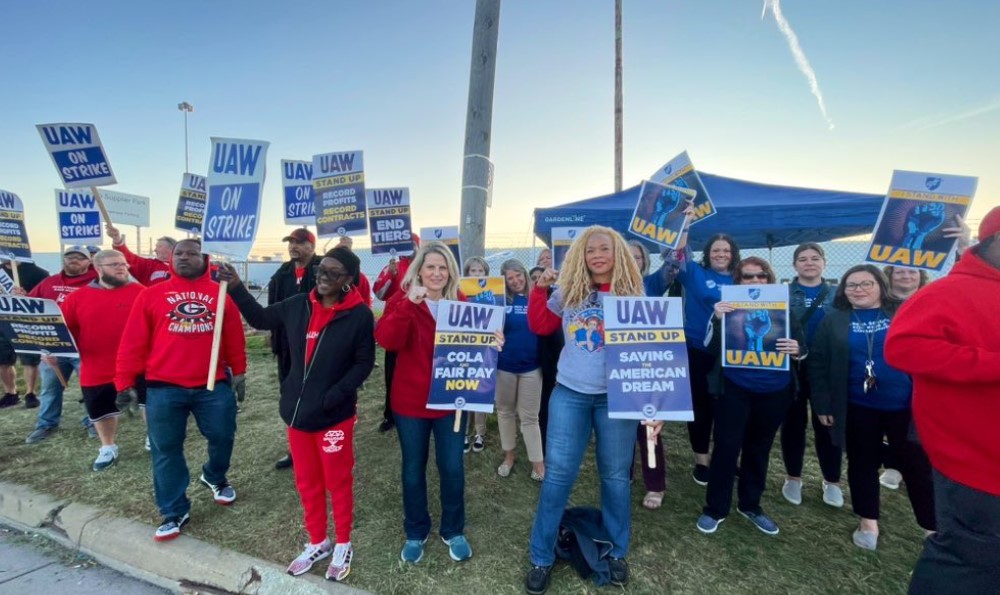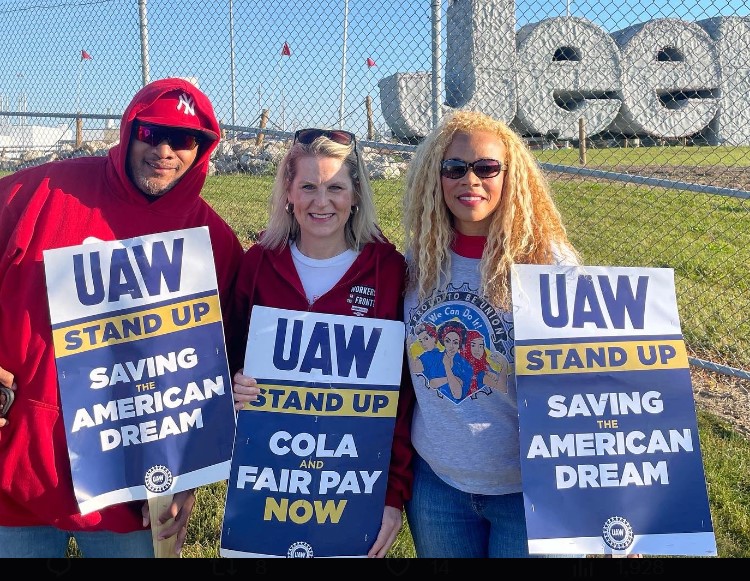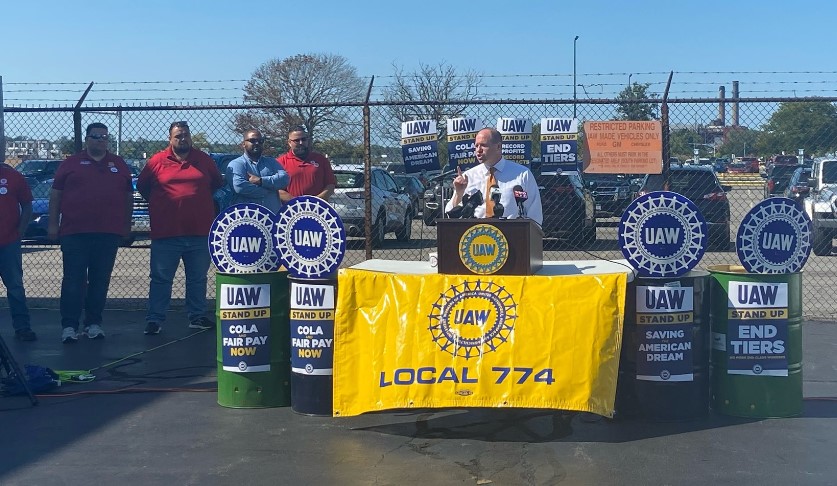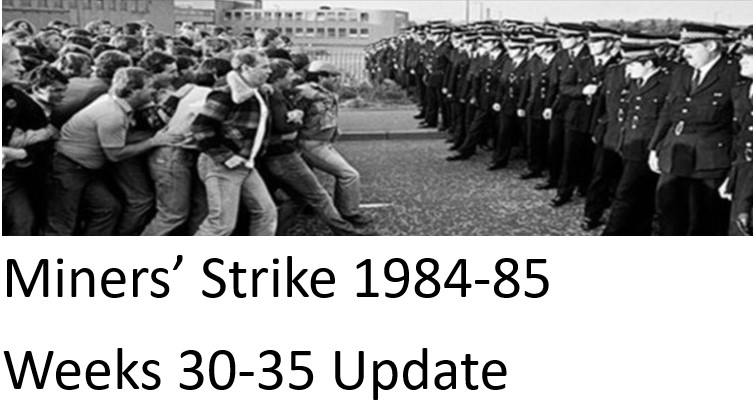By Richard Mellor in California
I just watched the video (below) which is UAW president Shawn Fain’s latest update on the strike against the big three US auto manufacturers: Ford, GM and Stellantis, formerly Chrysler. This is the first time that a strike has been called at all three manufacturers at the same time
It is rare for labour disputes to receive much media attention, but the US auto industry and its suppliers are America’s largest manufacturing sector, responsible for 3% of GDP. “No other manufacturing sector generates as many American jobs. Not only are they America’s largest exporters, they also buy hundreds of billions of dollars worth of American steel, glass, rubber, iron, and semiconductors each year.”, according to the American Automotive Policy Council that represents the industry.
President Fain is part of a reform group, Unite All Workers for Democracy, that threw out the conservative old guard in a recent election. The new leadership has gone on the offensive attacking “corporate greed” and demanding a 40% increase in pay over four years to make up for what was lost when the previous union leadership agreed to help the industry survive in the first decade of the century.
Most car workers work 50 to 60 hours a week
Whether that figure would account for the lost wages, I can’t say. I’m sure it wouldn’t dent the billions in profits, the investors in the industry have made over time. A shorter workweek and the return of the defined benefit pension plan, ending the wage tier system and the right of the UAW to represent workers in the plants making batteries for electric vehicles, are other major union demands.
Shawn Fain pointed out in an interview that most auto workers work 50 to 60 hours a week, so perhaps the shorter workweek demand might be directed at those figures, rather than the traditional 40 hour workweek which is history for most workers. What is absent from the unions proposals, is abandoning the Team Concept, the dominant ideology of the labour hierarchy that argues bosses and workers have the same economic interests.
Fain offers up useful statistics, pointing to the $250 billion in profits the big three raked in for the first six months of 2023. The average price of a new car has risen 30% in the last four years, says Fain, while workers’ wages have risen 6% in the same period. “Do you think wages are driving it”, he says of these increases. All these points are useful, but they are not new to working class people throughout the country and in all industries.
The ‘stand up’ strike and what it means
Early in the video brother Fain points out that, “We’re on strike at all three of the big three” which is technically true, but that does not mean they are all out. Three plants have been struck in what Fain tells us is “a new approach to striking” which he refers to as the “Stand up strike.”
This is where select locals will walk out and others don’t. It is supposed to sow some confusion among the auto bosses, from what I understand, and it is as important not to walk out and stay on the job, as it is for the selected plants to walk. I do not mean to be cynical here, but it would be fascinating to find out how this new strategy was developed as, “our generation’s answer to the movement that built our union”
For those workers and young people who are completely unaware of the movement that built the UAW and of working class history in general – and there are unfortunately way too many – the UAW and industrial unionism, was built by defying anti-union laws, occupying plants and workplaces and open battles with the police and hired thugs. Occupations of workplaces shielded strikers from the beatings they took on the lines as the bosses value their plant and equipment more than a worker’s life.
The Democratic Party needs workers’ support
It’s hard to imagine how this new strike approach can be more successful than pulling the entire workforce of the ‘Big Three’ out at the same time. My answer is, it can’t. As things stand, the Biden Administration has sent in his aides in order to ensure things don’t go too far.

Fain and the Democrat Bernie Sanders, are assailing the auto bosses for their greed and as we are inching closer to an election year Democrats are concerned about the party’s ability to make gains. The party needs workers’ support and the trade union hierarchy in particular. The political crisis is such that the two most powerful capitalist parties on the planet cannot field but two aging behemoths of a bygone era for president.
The UAW has not yet endorsed Biden for President, so this strike is important to the Democrats for that reason alone. But it’s also the reason the union is not pulling its members at the big three off the job. None of them ever mention it, but the trade union leadership atop the AFL-CIO and Fain, know very well that a major disruption to the economy like that will bring the same response from the Biden Administration the rail workers got.
Any trade union leader in this position and serious about the words they utter, would have to publicly warn the present administration that they are prepared to defend their actions and will not abide by legislative attempts to deny them their right to strike for what their members need to live a somewhat decent life. They won’t say this, of course, because, sadly, the trade union hierarchy is the only force in society that actually obeys the law, except when it involves their own members.
There is tremendous support among the US public for the auto workers and their union. The US working class has been savaged through decades of austerity and the shifting of manufacturing, primarily to places like China, Vietnam, Cambodia and Bangladesh, where workers are much cheaper and unions, regulation and other obstacles to unionism are weak or not present at all.
This strike is “our generation’s defining moment” – Fain
So these three plants out on strike represent about 15,000 out of the almost 150,000 workers the big three employ. This tactic is designed to push the auto bosses a bit but not to hurt the industry too bad. It’s inconceivable that any trade union leader would not have in the back of their mind, the inevitable interference of the state if profits are threatened. The auto companies have made so much money since the bail-outs in the first decade of this century that there’s a lot of wiggle room for them.
Fain says that this strike is, “Our generation’s defining moment” and there is no doubt it is a big one. But we have had a few “defining moments” opportunities to change the balance of class forces in society yet the trade union hierarchy has so far managed to snatch defeat from the jaws of victory.

There are huge stakes here for the bosses and the Democratic Party. Some significant gains, as has been the case with previous major strikes, would inspire millions of workers and open up some cracks in the dominant view that we can’t win, that we can’t change the inevitable.
In particular, it will have a positive effect on the non-union plants in the US South. The UAW’s organising drives there have failed, not because these workers are anti-union, far from it. The cause has been the pathetic organising strategy of the union leadership and their concessionary approach to it.
Non-union workers are not inspired to join a union with a proven track record of defeats and in some cases collaboration with the bosses against union drives. There are many such disasters in the UAW’s history: the strike at the Freightliner plant in Cleveland, North Carolina, is just one of them. Power attracts, passive resistance does not.
No union can win alone
It is hard to imagine the auto companies not making some concessions given the consequences of a long strike. What is clear is that we can’t beat global capitalism in isolation. Every union struggle must deal with social issues, poverty, jobs, immigration, mass transportation which is what is at stake here.
It is a serious omission, not raising the need to take this industry into public ownership and also to re-tool the industry for the production of mass [public] transport, as opposed to the inefficient auto.
Also, no union can win alone. As I pointed out in a previous commentary, there are some 600,000 workers on strike or considering it. The ILWU, representing West Coast dock workers, has been in negotiations almost a year; the bosses love that. The entertainment industry is still out. The flight attendants are threatening to strike. What tremendous potential power slumbers in the lap of social labour, someone famous once wrote. We have the power to change society and the world, but not if we don’t use it. And our present leaders will not.

Climate change should also be top of the list of issues crucial to labour, because we all breathe air. This is particularly so for an industry like auto, that produces so much environmental pollution. So I end with this on Electric Vehicles.
Electric Vehicles are not the answer
EV’s are not the answer to the combustion engine and fossil fuels. The shifting of auto production to the manufacture of EV’s will require far fewer workers than are in the industry now. The mining of the lithium needed for the batteries also has serious environmental and social consequences.
Lithium is mined in salt flats in arid regions of the planet. Bolivia, Chile and Argentina are major producers and there are new mines opening up in the US. The lithium is mined by a process known as brine extraction. It sounds similar to fracking. “Large amounts of groundwater are pumped from the surface and heated to separate out the lithium. The pumped-out water contains high concentrations of chemicals, including sulfuric acid and other toxic substances.” (from The Dirty Secret of Lithium Mining for Electric Car Batteries)
Lithium mining has very negative effects on the environment and particularly among indigenous communities, as it poisons the land and water, and evicts them from their ancestral homes. There have been protests against Lithium mining by indigenous communities throughout the world. It is also widely believed that the US-backed coup that overthrew the Evo Morales government in Bolivia had a lot to do with western capital getting its hands on the country’s lithium deposits.
The UAW strike is another opportunity to change the course of history, with a program that speaks to the needs and desires of millions of workers, especially the youth whose future is aat stake. But with any war, and this is class war, victory is not assured. It depends on how we fight it.
Video on Lithium mine construction in Nevada and Native American opposition to it:
From the US socialist website, Facts for Working People. The original can be found here. All inset pictures and top picture are from UAW Twitter feed, here.



